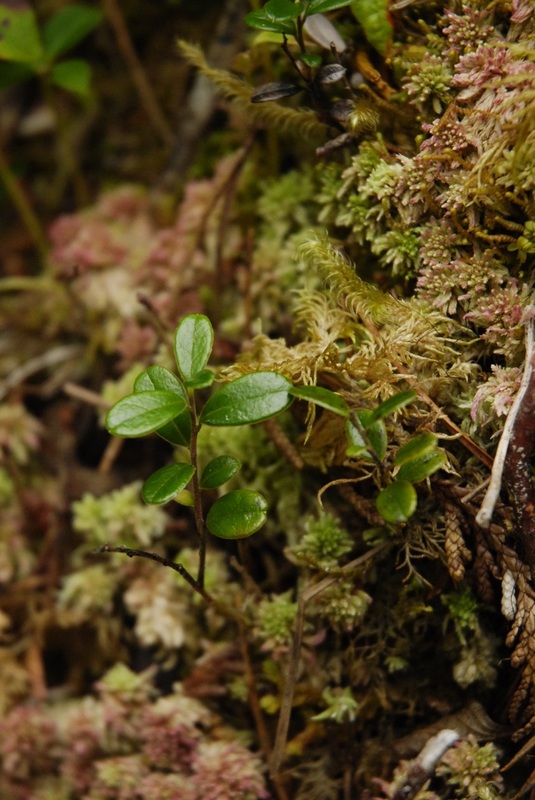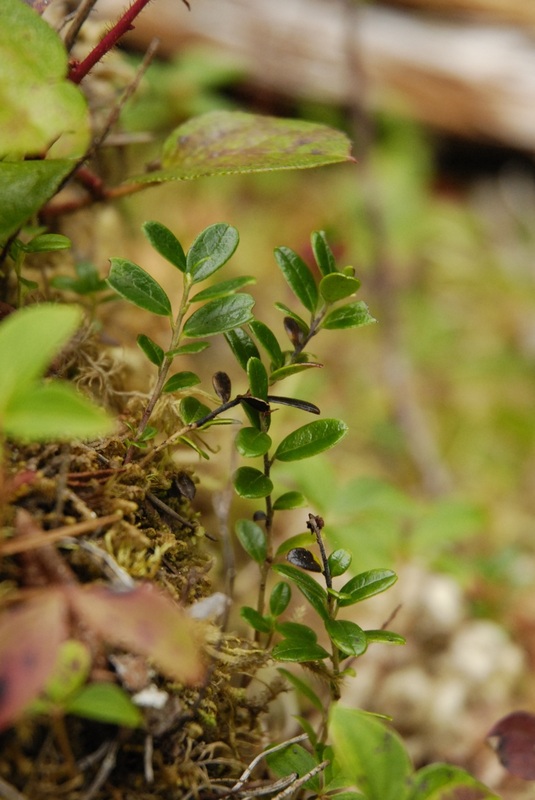Kinnikinnick • Arctostaphylos uva-ursi • Nuxalk - milicw (berry)
Identification
Kinnikinnick is a small trailing evergreen shrub. It tends to form mats, and its upright branches grow to 20 cm tall. It has reddish-brownish peeling bark. The dark green leaves are oval- to spoon-shaped, somewhat shiny on top, have a leathery texture, and alternate along the stem. The tips are usually rounded, though they may occasionally be somewhat pointed. Clusters of small, pinkish-white, urn-shaped flowers droop from branch tips. The berries are bright red and spherical, and remain on branches through the winter.
Habitat & Range
Kinnikinnick grows in well-drained locations. Throughout BC it is most often found in exposed and sandy or rocky sites, as well as in the understory of open pine forests. It grows from low to subalpine elevations. Its coastal range extends from Alaska to California, and it is found across much of Canada and the northern United States as well as in the Rocky Mountains as far south as New Mexico. It is also found in areas of Eurasia.
Similar Species
Lingonberry (Vaccinium vitis-idaea) and dwarf blueberry (V. caespitosum) can appear similar during certain seasons. Lingonberry leaves also alternate and are dark, leathery, and of a similar shape. Lingonberry leaves have rounded edges, can be slightly toothed and may have a notch at the tip, the undersides of the leaves bear black dots, and the flowers are bell-shaped as opposed to urn-shaped. Differentiation can be hampered by the slight variability in leaf shape in both species. Dwarf blueberry flowers can appear quite similar, but its leaves are bright green on both sides and are distinctly toothed. Hairy manzanita (Arctostaphylos columbiana), found on the extreme south coast of BC, has greyish-green leaves that are conspicuously different from those of kinnikinnick; however where their ranges overlap these two Arctostaphylos species hybridize. All these species have edible berries, so confusion is not as serious a matter as it could be otherwise.
Human Uses
Kinnikinnick berries are edible but mealy and tasteless, but were an important traditional food source for some First Nations groups because of their persistence on branches throughout the winter. Due to their texture and lack of taste, the berries were usually processed, cooked, or preserved in some way. The leaves were smoked, though this does not appear to be a traditional practice from before the past couple hundred years. Bearberry (Arctostaphylos spp.) leaf teas and extracts have a number traditional medicinal uses.
Intriguing Info
Excessive consumption of Arctostaphylos (bearberry) berries and leaves is not recommended due to their high levels of tannin and arbutin, which can cause stomach and liver issues. They can also cause issues for pregnant women.
iNaturalist
https://www.inaturalist.org/taxa/68049-Arctostaphylos-uva-ursi
Kinnikinnick is a small trailing evergreen shrub. It tends to form mats, and its upright branches grow to 20 cm tall. It has reddish-brownish peeling bark. The dark green leaves are oval- to spoon-shaped, somewhat shiny on top, have a leathery texture, and alternate along the stem. The tips are usually rounded, though they may occasionally be somewhat pointed. Clusters of small, pinkish-white, urn-shaped flowers droop from branch tips. The berries are bright red and spherical, and remain on branches through the winter.
Habitat & Range
Kinnikinnick grows in well-drained locations. Throughout BC it is most often found in exposed and sandy or rocky sites, as well as in the understory of open pine forests. It grows from low to subalpine elevations. Its coastal range extends from Alaska to California, and it is found across much of Canada and the northern United States as well as in the Rocky Mountains as far south as New Mexico. It is also found in areas of Eurasia.
Similar Species
Lingonberry (Vaccinium vitis-idaea) and dwarf blueberry (V. caespitosum) can appear similar during certain seasons. Lingonberry leaves also alternate and are dark, leathery, and of a similar shape. Lingonberry leaves have rounded edges, can be slightly toothed and may have a notch at the tip, the undersides of the leaves bear black dots, and the flowers are bell-shaped as opposed to urn-shaped. Differentiation can be hampered by the slight variability in leaf shape in both species. Dwarf blueberry flowers can appear quite similar, but its leaves are bright green on both sides and are distinctly toothed. Hairy manzanita (Arctostaphylos columbiana), found on the extreme south coast of BC, has greyish-green leaves that are conspicuously different from those of kinnikinnick; however where their ranges overlap these two Arctostaphylos species hybridize. All these species have edible berries, so confusion is not as serious a matter as it could be otherwise.
Human Uses
Kinnikinnick berries are edible but mealy and tasteless, but were an important traditional food source for some First Nations groups because of their persistence on branches throughout the winter. Due to their texture and lack of taste, the berries were usually processed, cooked, or preserved in some way. The leaves were smoked, though this does not appear to be a traditional practice from before the past couple hundred years. Bearberry (Arctostaphylos spp.) leaf teas and extracts have a number traditional medicinal uses.
Intriguing Info
Excessive consumption of Arctostaphylos (bearberry) berries and leaves is not recommended due to their high levels of tannin and arbutin, which can cause stomach and liver issues. They can also cause issues for pregnant women.
iNaturalist
https://www.inaturalist.org/taxa/68049-Arctostaphylos-uva-ursi
References
Arctostaphylos uva-ursi (L.) Spreng. In Klinkenberg, Brian. (Ed.). E-Flora BC: Electronic Atlas of the Plants of British Columbia. Lab for Advanced Spatial Analysis, Department of Geography, University of British Columbia, Vancouver. Accessed 05/11/2014.
Mackinnon, A. et. al. Edible & Medicinal Plants of Canada. Vancouver, BC: Lone Pine Publishing. P. 252.
Pojar, J. and MacKinnon, A. (1994). Plants of Coastal British Columbia. Vancouver, BC: Lone Pine Publishing. Pp. 120-121.
Pojar, J. and MacKinnon, A. (1994). Plants of Coastal British Columbia. Vancouver, BC: Lone Pine Publishing. P. 67.
Authors and editors of page
Kelly Fretwell and Brian Starzomski (2014).
Arctostaphylos uva-ursi (L.) Spreng. In Klinkenberg, Brian. (Ed.). E-Flora BC: Electronic Atlas of the Plants of British Columbia. Lab for Advanced Spatial Analysis, Department of Geography, University of British Columbia, Vancouver. Accessed 05/11/2014.
Mackinnon, A. et. al. Edible & Medicinal Plants of Canada. Vancouver, BC: Lone Pine Publishing. P. 252.
Pojar, J. and MacKinnon, A. (1994). Plants of Coastal British Columbia. Vancouver, BC: Lone Pine Publishing. Pp. 120-121.
Pojar, J. and MacKinnon, A. (1994). Plants of Coastal British Columbia. Vancouver, BC: Lone Pine Publishing. P. 67.
Authors and editors of page
Kelly Fretwell and Brian Starzomski (2014).






